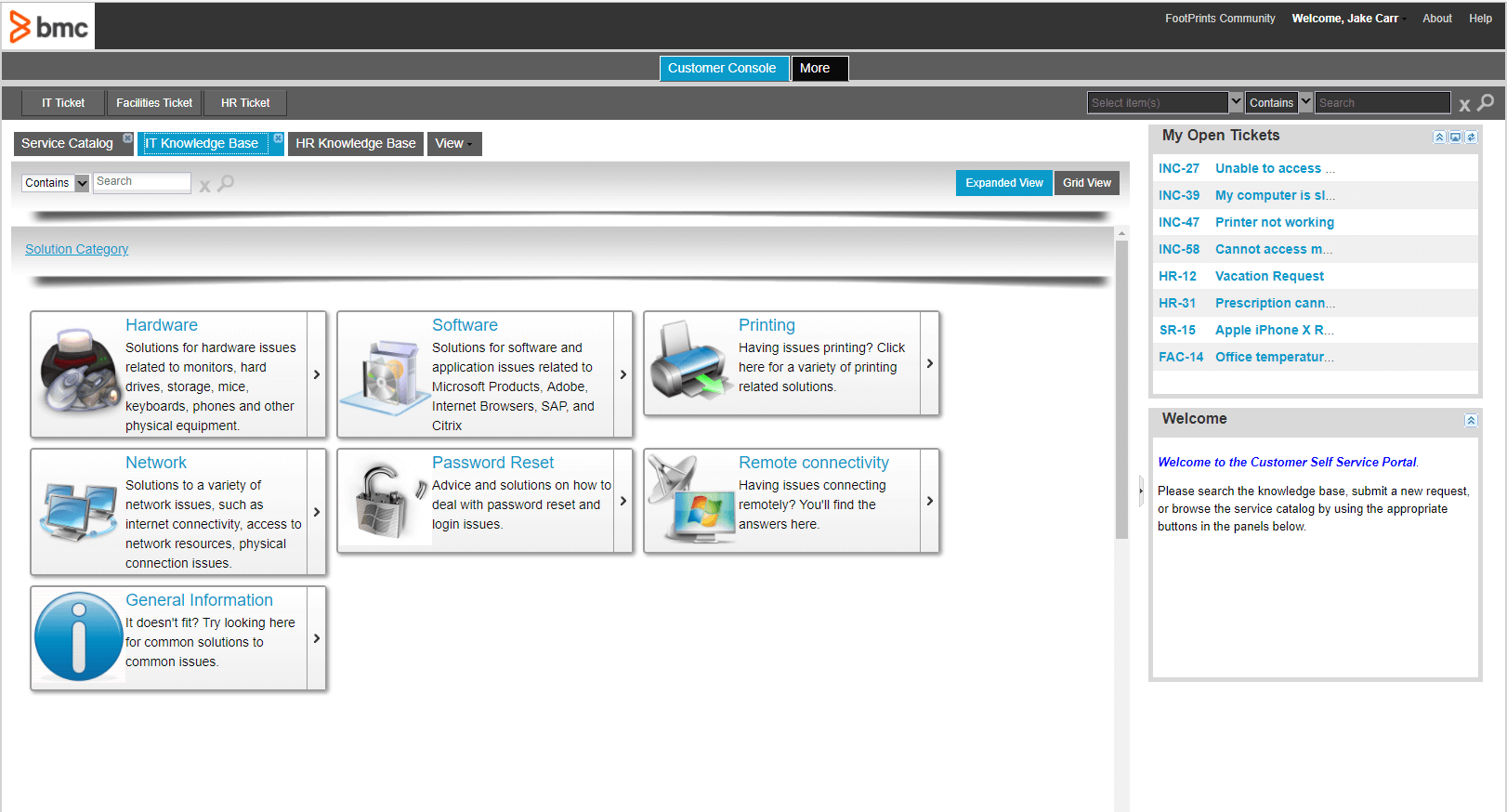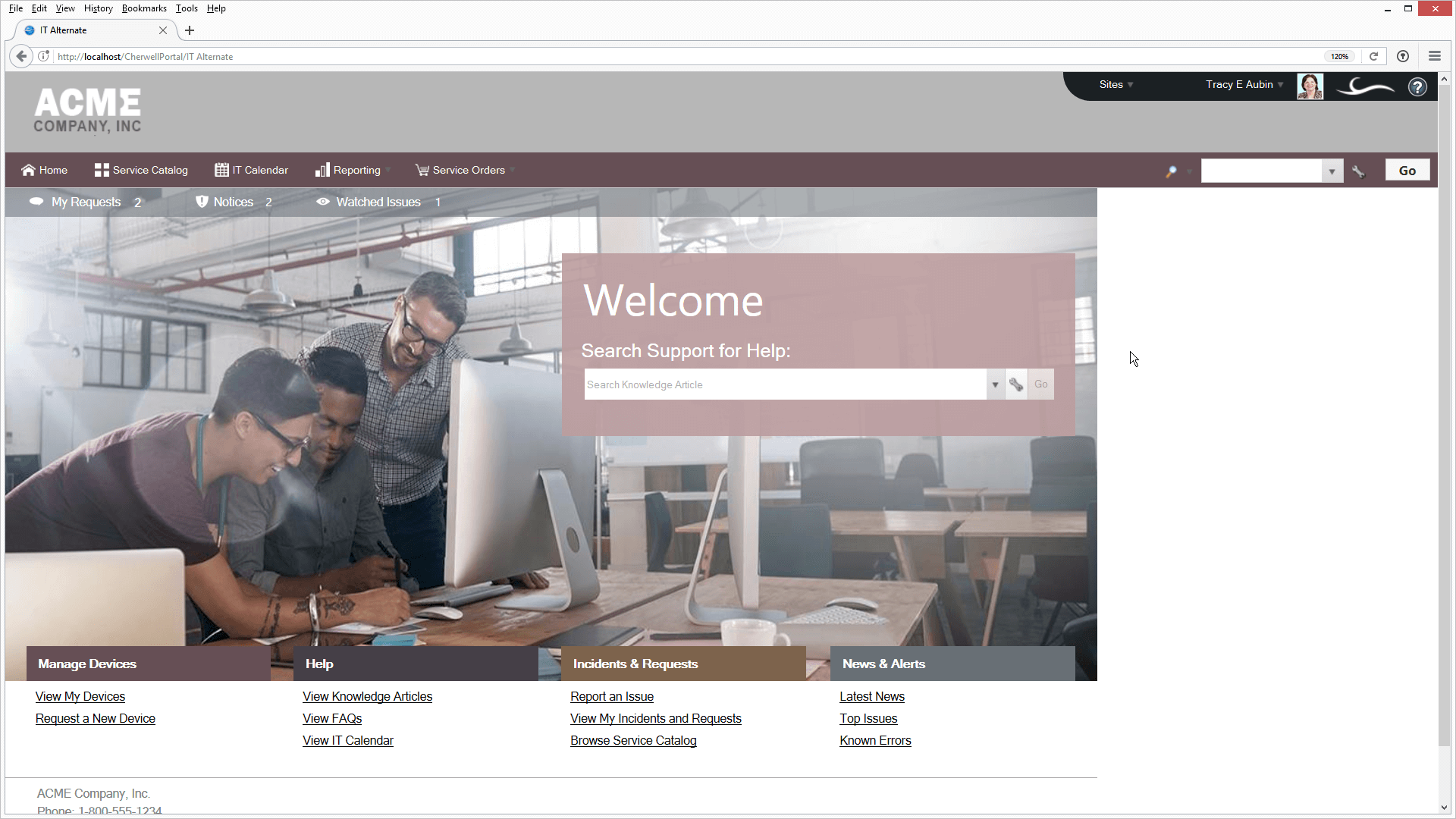What Is an IT Support or Helpdesk Portal?
As the IT department has evolved from a simple ‘’break fix’” service team to a strategic business partner, its main goal is to provide efficient service to internal customers and keep them working toward business goals without disruption. Roles and responsibilities vary by organization, but support agents, change managers, and asset managers all help ensure services (access to technology, training, information security, etc.) are successfully delivered to support the business’s bottom line. They can do so through an IT helpdesk portal.
An IT helpdesk portal provides a one-stop shop for day-to-day technology resources. An organization's employees (referred to as end-users, clients, partners, or customers) utilize the portal to request IT services and resolve technical challenges. The portal is intended to offer self-service support options that reduce the need for human intervention. Some cases can be escalated to a support agent if necessary, and customers can submit requests that will then work their way through the process to resolution.
Must-Have Features in Tech Support and IT Helpdesk Portals
An IT helpdesk portal is the first line of communication between the IT staff and their internal customers. The most basic functions include the ability to request services (such as equipment ordering and setup, network access/permissions, and software updates), as well as reset passwords, access training materials, search a knowledge base, and chat with IT support staff.
In addition, look for solutions that include the following features:
- Knowledge base
- Frequently asked questions (FAQs)
- Training modules or tutorials
- Categorization options for easy searching
- Natural language search
- Flexible deployment options (on-premise or SaaS)
- Ability to configure and/or customize
- Discussion forums
- Branding capabilities
- Email support
- Dashboards, reporting, and metrics
- Secure, permission-based access
- Active directory integration
- Multichannel (email, web, mobile) support
- Customer satisfaction surveys
- Request submission
- Service catalog
- Human chat and/or artificial intelligence-driven chatbot
- Multiple language support
- Automated ticket workflow
- Asset and configuration management integration
- Audit trail history
- Escalation notifications
- Remote control
- Status checks and ticket progress tracking
- Single, integrated portal for all end-user needs
- Custom ticket views/search
- Service level agreements (SLA)
You should also consider new, innovative technology when evaluating software vendors.
Benefits and Challenges of an IT Helpdesk Portal
An effective IT helpdesk portal provides tremendous benefits to both the internal customers and the IT department. For IT, the sheer amount of supported technology in use strains limited resources.
Customer Benefits
- Improve customer satisfaction
- Reduce wait time
- Increase productivity
- Improve communication
Business Benefits
- Increase transparency
- Reduce support agent workload
- Reduce costs
- Reduce ticket volume
- Improve first call resolution rate (FCR)
- Increase productivity
- Improve communication
Remember, you’ll only realize the benefits of an IT helpdesk portal if your customers use it.
Rich Graves finds a similar issue: “Too many organizations push to get a portal out that meets the needs of IT or the organization, rather than the end-user. This leads to poor usability because they are not gaining a full understanding of their end-user’s communication style.”
Don Cholish offers this advice: “Remember that most customers will only occasionally visit the portal and to keep it as simple as possible for their basic needs. The challenge lies with satisfying power users who desire more advanced access. Make the initial screen as simple as possible with the most common tasks, then advanced options available with a little navigation or search. The power users will find what they need.”
The Importance of an IT Support Help Desk Portal in Healthcare Organizations
Technology usage in healthcare organizations is gaining traction, with more and more automated, technology-focused processes taking the place of outdated, manual ones. Healthcare devices, patient data, protected health information (PHI), legal information, and more, are all being tracked and managed within IT services and platforms.
To ensure that IT departments can best serve the providers and team members who use IT systems within healthcare, they need a helpdesk portal to maintain productivity and safeguard life-sustaining processes. To do so, healthcare organizations need a collaborative, real-time tool that enables IT departments to intake, track, manage, and act on all help tickets and risks that may arise while using IT systems.
Smartsheet is a work execution platform that enables healthcare companies to improve IT work efficiency, scale business processes, and securely manage and store PHI, while meeting or exceeding all of HIPAA’s regulatory requirements. Streamline reporting, track and manage assets and technology resources, and organize all necessary information in one centralized location to ensure your IT help desk operations run efficiently, and all problems are addressed immediately.
Interested in learning more about how Smartsheet can help you maximize your efforts? Discover Smartsheet for Healthcare.
Designing a Tech Support or Helpdesk Portal
When creating your helpdesk portal, keep the customer in mind. Customers will more readily adopt a portal that is easy to use and provides a familiar user experience.
Most solutions include a minimum level of functionality and the ability to configure based on your business needs. A good system sends a message that says it is here to help. You want end-users to feel confident that using the portal is the fastest method to resolve issues. To do so, design the portal with simplicity and practicality in mind.
In addition, mimic your organization’s brand to provide a familiar look and feel — this will drive greater adoption.
Best Practices: 5 Tips for a Successful IT Helpdesk Portal
Many of today's helpdesk solutions support the IT Infrastructure Library (ITIL) best practice framework. Service catalog management is an ITIL process that encourages the use of an IT service catalog to provide IT products and services to end-users in a storefront-style portal. Many organizations adopt the ITIL framework to improve the services they deliver to end-users. Below you will find additional tips for a successful IT helpdesk portal:
- Keep it simple and intuitive. “Simple” and “easy” are terms that are commonly associated with customer portals.
- Respond quickly. Consumers are accustomed to on-demand service, and they carry those expectations with them into the business environment.
- Define an escalation path.
- Prioritize accessibility and security. “Accessibility” is often synonymous with mobile device access, but it is also essential to consider accessibility for IT staff and customers with disabilities.
- Have a marketing plan for the portal.
Helpdesk portals are important for efficiently managing technology in the workplace. Similar to any other business process, the IT helpdesk customer experience is ever-evolving and should be continuously evaluated and improved. To deliver real, tangible benefits to customers, gather their feedback and act on it, analyze processes for improvement opportunities, constantly improve knowledge base content, and monitor IT’s response rate. The right IT helpdesk portal solution designed with the end-user in mind increases productivity while allowing IT departments to accomplish more with fewer resources.
Design Your IT Helpdesk Portal with Smartsheet for IT & Ops
Empower your people to go above and beyond with a flexible platform designed to match the needs of your team — and adapt as those needs change.
The Smartsheet platform makes it easy to plan, capture, manage, and report on work from anywhere, helping your team be more effective and get more done. Report on key metrics and get real-time visibility into work as it happens with roll-up reports, dashboards, and automated workflows built to keep your team connected and informed.
When teams have clarity into the work getting done, there’s no telling how much more they can accomplish in the same amount of time. Try Smartsheet for free, today.










